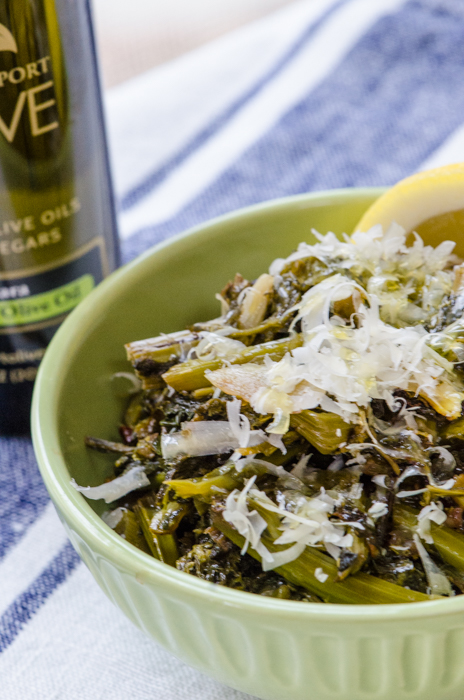
Discovering the distinctive local products of Italy is a unique and intriguing part of any Italiaoutdoors Food and Wine Italy tour, an activity that requires extensive local knowledge. There are countless local varieties of plants that are incorporated into the traditional cuisine and wines of Italy. But due to this country’s unique geography, these particular species have been isolated to a small area, and may only be found and used within a couple of kilometers. More and more local trattorie in Italy are offering “0km menus”, featuring these local specialties, and are a favorite spot to include on our tours.
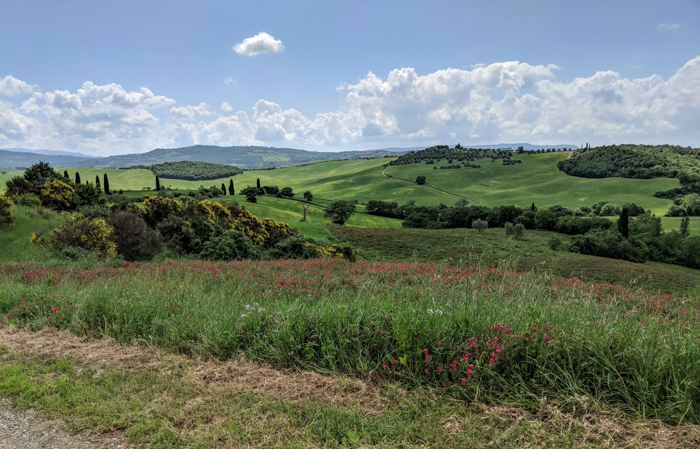
Here’s a quote from one of my favorite Italy cookbooks, Osteria: 1,000 Generous and Simple Recipes from Italy’s Best Local Restaurants, from a recipe for a Foraged Greens and Herbs soup from Lombardia – “Ramps, maidenstears, pellitory-of-the wall nettles, primrose, violets, meadow clary, tender linden leaves, good king Henry, purple salsify, baby lettuce, sorrel, shepard’s purse, wild cardoon shoots, thyme, oregano: these are just some of the wild greens and herbs that can be foraged in the area in and around Bergamo.” (a city in Lombardia, near Lake Como.) Foraging – almost unheard of here – is still practiced commonly in the Italian countryside. Travel 20 km down the road, and this list of foraged plants will be different!
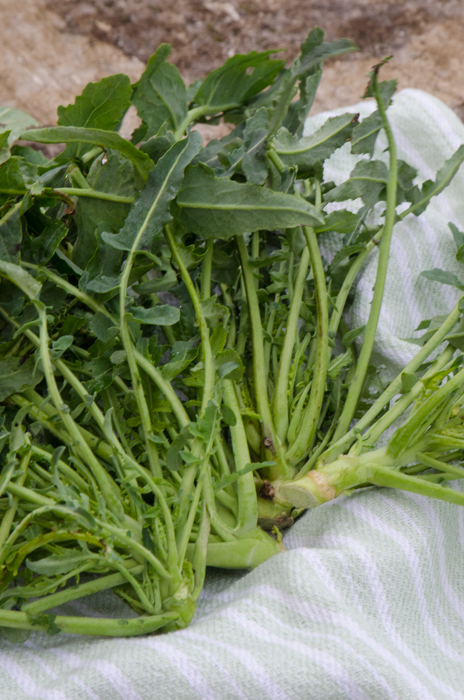
When I return to Italy in a few short weeks, I will find Fiolaro di Creazzo, a local broccoli, at my neighborhood produce vendor. Fiolaro broccoli is unique, as it does not resemble other varieties of broccoli either in form or in taste. It does not form a flower, but instead produces small secondary shoots along the stem of the plant which are called fioi and have given this plant its name. Grown on the hills of Creazzo, just west of Vicenza, this plant flourishes in the rich soil on south facing slopes, where the winter is dry, not too cold, but with brief November frost (-8/10°C) that makes the fiolaro more tasty.
To find many of these greens, you have to travel to Italy. But a few we can find here in the US include the Tuscan or Lacinato kale, in Italian cavolo nero, or black kale. This kale has long, dark green, narrow leaves with a bumpy surface. As with the Fiolaro, the most flavorful have been through at least one frost. In Tuscany it finds it’s way into the favorite Ribollita Toscana soup, or served on a crostini with lots of fresh olive oil.
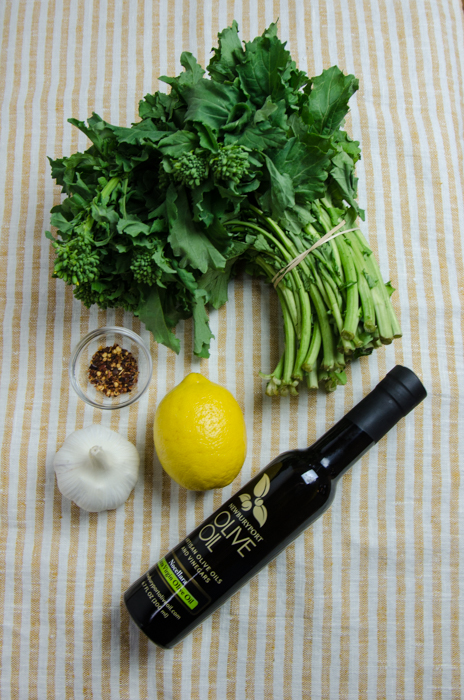
Rapini or Cime di Rapa or known in the US as Broccoli Rabe, is a member of the cabbage family. It has a 6 to 9 inch stalks with a few broccoli-like clusters, both of which are edible. This green has a distinctive bitter taste, and appears most often in southern Italian cuisines, including Campania (where it is called friarielli) and Puglia, (where it is called cime di rapa).
I have a few articles in the works that call for cooked greens, so I needed to start with a basic recipe. I have many a recipe for spicy sauteed greens from all parts of Italy. But the one fault I have with the vast majority of original Italian recipes is a lack of precise, detailed instructions. Italian assume everyone knows how to cook, so only general guidelines are necessary. The long lost ex-engineer in me can’t just live with this state of affairs.
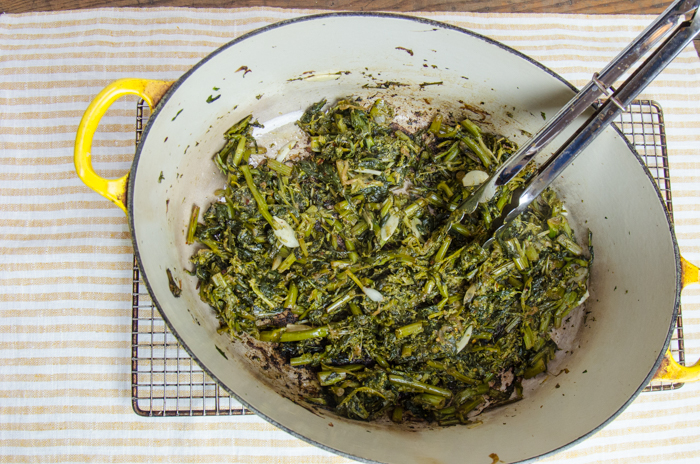
So I turned to a non-Italian cookbook that is a great resource for those of us who want to know “why” we cook something a certain way: Salt, Fat, Acid, Heat: Mastering the Elements of Good Cooking by Samin Nosrat. Books like these, that contained well-tested recipes, clear and detailed instructions, inspire my rewrites of the Italian originals so my readers and our clients can reproduce the wonderful dishes we taste on tour back at home.
Nosrat’s recipe follows – it uses the very same ingredients found in the Italian versions of this recipe, but offers much more complete instructions, including when to season, how to add and Incorporate the garlic without burning it. You can apply this same technique to other greens like kale and mustard greens, with some adjustment on the length of cooking time.
Nosrat serves this with Ricotta Salata cheese (a dry, salted ricotta) which I find only rarely here in the US. Any good quality hard cheese, such as Parmigiano-Reggiano or Grana Padano, will work too.
Rapini all’Aglio, Olio e Peperoncini – Spicy Broccoli Rabe
2 bunches (about 2 pounds) broccoli rabe, rinsed
Extra-virgin olive oil
1 medium onion, thinly sliced
Kosher salt
Big pinch hot red pepper flakes
3 garlic cloves, sliced
1 lemon
Cut off and discard the woody ends of the broccoli rabe. Slice the stems into 1/2-inch long pieces, and the leaves into 1-inch pieces.
Set a large Dutch oven or similar pot over medium heat. When it’s hot, add 2 tablespoons olive oil to coat the bottom of the pot. When the oil shimmers, add the onion and a pinch of salt. Cook, stirring occasionally, until the onion is soft and beginning to brown, about 15 minutes.
Increase the heat to medium-high, add another tablespoon or so of oil, and the broccoli rabe to the pot, and stir to combine. Season with salt and red pepper flakes. You might need to mound the broccoli rabe to make it fit, or wait for some of it to cook down before you add the rest. Cover the pan and cook, stirring occasionally, until the broccoli rabe is falling apart tender, about 20 minutes.
Remove the lid and increase the heat to high. Let the broccoli begin to brown, then use a wooden spoon to move it around the pan. Continue cooking until all the broccoli has evenly browned, about 10 minutes, then move it all to the outer edges of the pan. Add a tablespoon of olive oil into the center, then add the garlic into the oil and let it sizzle gently for about 2 seconds, until it starts to release an aroma. Before the garlic begins to brown, stir to combine it with the broccoli. Taste and adjust the salt and red pepper flakes as needed. Remove from heat and squeeze the juice of half a lemon over the broccoli.
Stir, taste, and add more lemon juice if needed. Heap onto a serving platter and shower with coarsely grated cheese. Serve immediately.

Pingback: Bistecca di Cavolfiore con Cima di Rapa e Formaggio - Cauliflower Steak with Greens and Cheese | Italian Food, Wine, and Travel